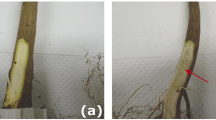Abstract
Entyloma calendulae f. sp.dahliae overwinters in the soil as teliospores or in dead leaf tissue. It was not seed — transmitted and did not survive in tubers although it occurred in soil attached to tubers. Teliospore germination decreased from the end of November to a minimum between January and March. Spores exposed to wintry conditions remained dormant longer than those in the laboratory. In spring and early summer some overwintered spores germinated in the soil to give rise to conidia resembling those normally produced on leaves. Fresh outbreaks of the disease occurred in July from spores which had overwintered in the soil. The host tissues nearest to the ground are infected first and the disease remains more severe on the lower part of the plant than on the upper leaves. New tissues were infected throughout the summer, giving a maximum in early autumn. Many more conidia were present in the air on wet windy days than on dry calm ones.
Zusammenfassung
Entyloma calendulae f. sp.dahliae überwintert in Erdboden als Teliosporen oder im Gewebe toter Blätter. Es war nicht durch Samen übertragen und überlebt nicht im Knollen, obwohl es in der an den Knollen haftenden Erde vorkommt. Teliosporenkeimung nahm vom Ende November bis zu einem Minimum zwischen Januar und März ab. Sporen, die winterlichen Bedingungen ausgesetzt waren, blieben längerer Zeit dormant, denn diejenigen im Laboratorium. Im Frühjahr und Frühsommer keimten manche überwinterte Sporen in der Erde, um Konidien zu entwickeln, die denen normalerweise an den Blättern vorkommenden ähnlich waren. Ein neuer Ausbruch der Krankheit kam im Juli vor, die durch die im Boden über-winterten Sporen verursacht wurden. Das Wirtsgewebe, nähst dem Boden, ist erst infiziert und die Krankheit verbleibt schwerer im unteren Teil der Pflanze, denn in den obersten Blättern. Das neue Gewebe wurde durch den Sommer infiziert und die Höhe wurde im Frühherbst erreicht. Vielmehr Sporen waren in der Luft an nassen, windigen Tagen vorhanden, denn in ruhigem, trockenem Wetter.
Similar content being viewed by others
References
Ainsworth, G. C. &Sampson, K. (1950) The British smut fungi (Ustilaginales). Commonwealth Mycological Inst. Kew. Surrey, 137 pp.
Bray, B. (1963) Some observations on the sporidial stage of the life cycle inEntyloma species.Rev. Path. Veg. 32:23–36.
Green, D. E. (1932) Smut disease of dahlia caused byEntyloma dahliae (Sydow).J. Roy. Hort. Soc. 57:332–339.
Grouet, D. (1954) Recherches de quelques donnes fondamentales sur l'Entyloma du dahlia. Phytiatrie —Phytopharm 3:9–13.
Okaisabor, E. K. (1967) Studies on the smut disease of dahlia caused byEntyloma calendulae f.dahliae Ph. D thesis, University of Exeter. 241 pp.
Pethybridge, G. H. (1928) A new disease of dahlia.Gardeners 84:393–394.
Author information
Authors and Affiliations
Rights and permissions
About this article
Cite this article
Okaisabor, E.K. The epidemiology of leaf smut disease of dahlia caused by Entyloma calendulae f. sp. dahliae (Syd.) Viegas. Mycopathologia et Mycologia Applicata 39, 145–154 (1969). https://doi.org/10.1007/BF02053488
Accepted:
Issue Date:
DOI: https://doi.org/10.1007/BF02053488




